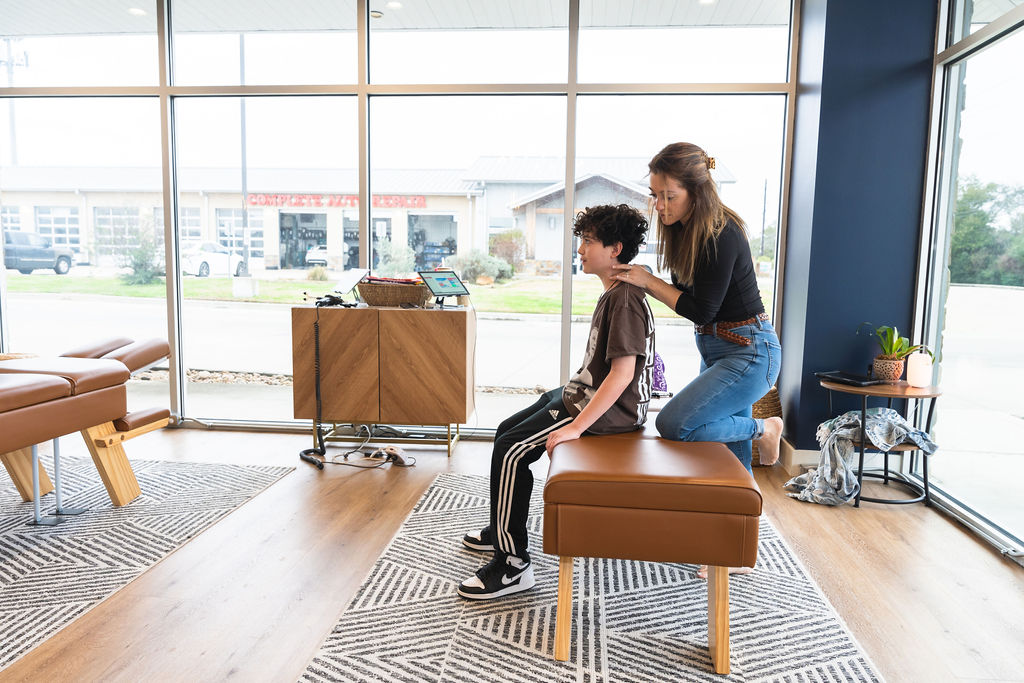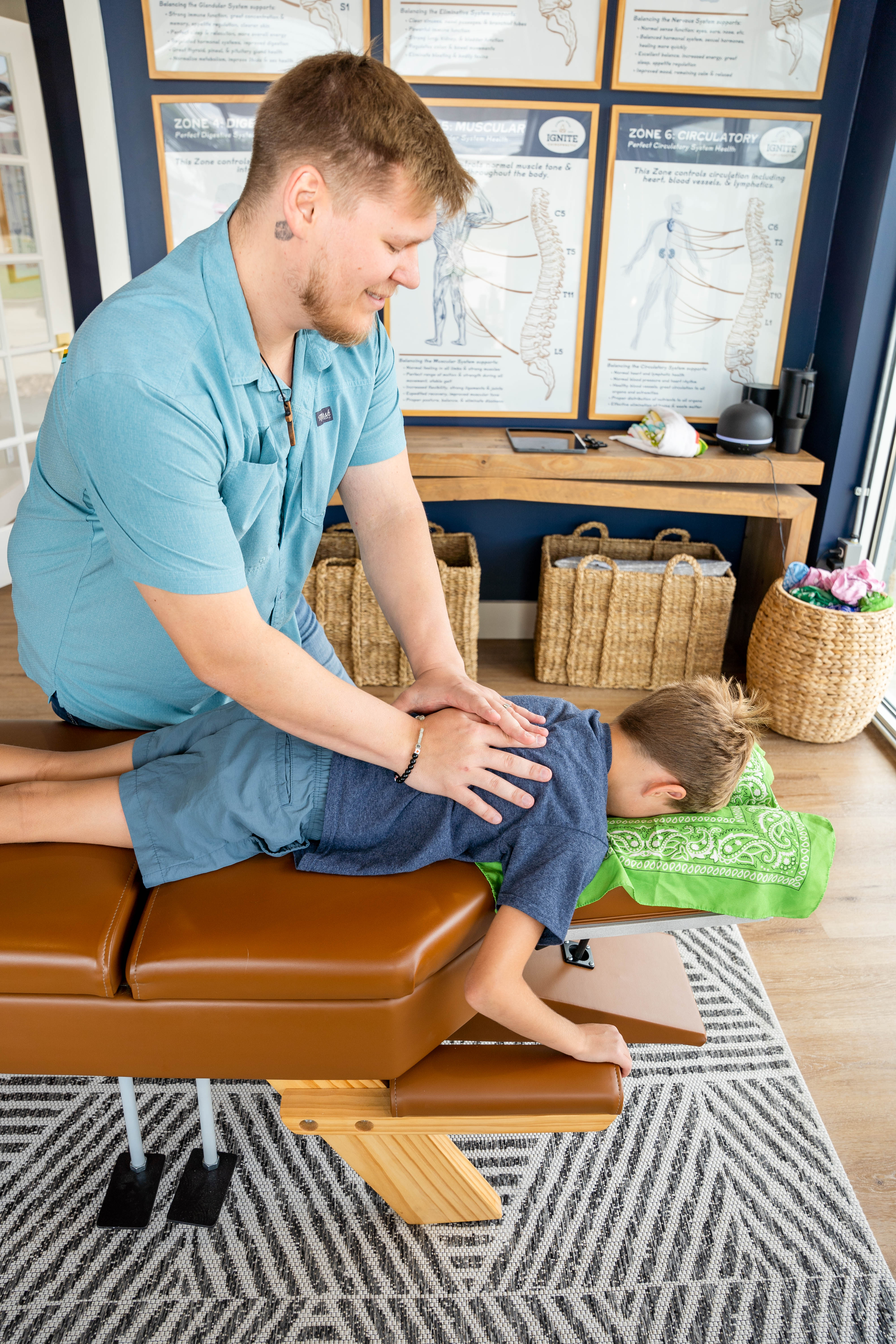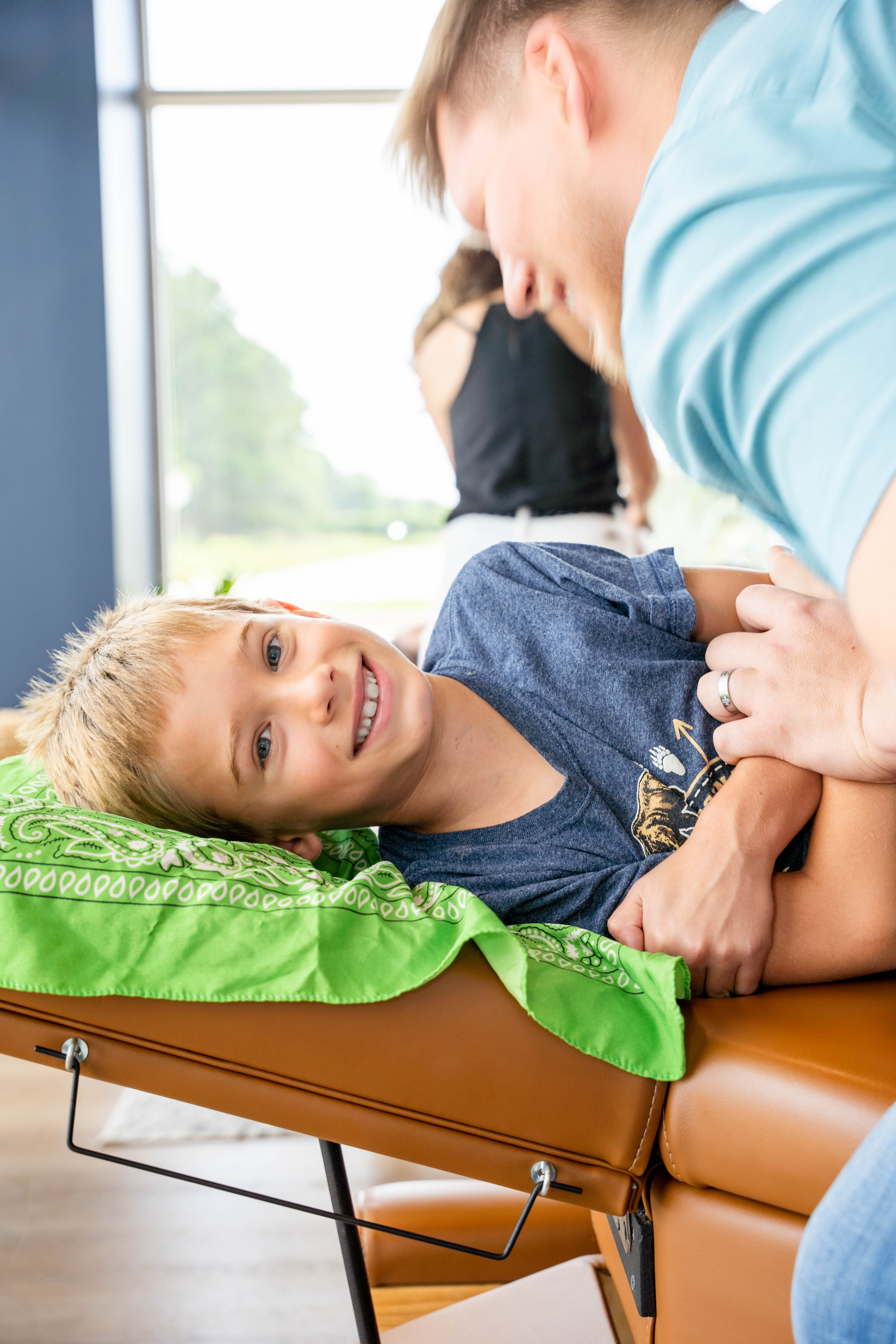How Nervous System Care Supports Kids with ADHD: A Parent-Centered Guide from Ignite Chiropractic

Understanding ADHD Through the Lens of the Nervous System
When parents hear “ADHD,” many picture restless feet, impulsive words, or endless energy that feels impossible to tame. But what if we saw these behaviors not as flaws, but as signals from a child’s nervous system? Understanding ADHD in children through the lens of the nervous system reveals a powerful truth: these kids aren’t broken—they’re communicating that their internal “wiring” needs extra support. At Ignite Chiropractic, we help families decode these signals, so healing can begin from the inside out. This isn’t just theory; research shows that children with ADHD often display measurable differences in brain connectivity and nervous system regulation, affecting everything from focus to sleep.
The Brain-Body Communication Loop—Why Misfires in Neural Messages Can Look Like Restlessness and Impulsivity
Imagine your child’s nervous system as a superhighway, sending messages from the brain to every part of the body and back again. When the highway is clear, the brain’s instructions travel smoothly—regulating emotions, helping kids stay on task, and making transitions less rocky. But when neural messages misfire, as often happens with ADHD, the signals get scrambled. This can show up as fidgeting, difficulty listening, or emotional outbursts that seem to come out of nowhere. One study published in Frontiers in Human Neuroscience found that children with ADHD have reduced efficiency in the brain’s default mode network, which helps regulate attention and self-control. When this network is disrupted, the body responds with restlessness or impulsivity as it tries to adapt. We see this in our practice every week: a child who struggles to sit through dinner, or one who finds it nearly impossible to wind down for bed. That’s why nervous system care is so essential for child mental health—it helps repair those broken lines of communication so kids can thrive. For more on how chiropractic can nurture this process, see Why Pediatric Chiropractic is Essential for Your Child’s Growth and Development.

Stress, Dysregulation, and Focus—How Chronic Fight-or-Flight States Drain Attention Resources
When a child’s body is on constant alert, their brain is like a smoke detector that never stops beeping. Chronic stress triggers the fight-or-flight response, flooding the body with stress hormones such as cortisol and adrenaline. Over time, this drains the brain’s resources needed for focus, memory, and emotional regulation. According to the CDC, up to 30% of children with ADHD also experience anxiety, making daily stress even harder to manage. We meet parents who are desperate for answers because their child seems “wired” at bedtime or melts down at every transition. It’s not just willpower; it’s a nervous system stuck in overdrive. Nervous system care—like adjustments that target specific areas of interference, or “subluxations” (misalignments that disrupt nerve flow)—can help bring the body back to a state of balance. Learn more about what subluxations are and how they affect Cypress-area families at Subluxations Explained: Causes, Symptoms & Natural Treatment for Cypress-Area Families. When stress is dialed down, the brain can finally rest, and focus returns—one small win at a time.
Metaphor: The Fuse Box—When One Switch Shorts Out, the Whole House (Body) Reacts
Think of your child’s nervous system as a fuse box. Each “switch” controls a different zone—digestion, mood, focus, sleep, and more. When one switch shorts out or gets overloaded, lights start to flicker all over the house. Maybe your child’s digestion is off, or sleep is restless, or frustration boils over at homework time. This isn’t random; it’s the body’s way of signaling that something deeper needs attention. At Ignite Chiropractic, we use the Zone Technique—a method that assesses and realigns six key brain-body zones—to help reset the system. When the nervous system is balanced, the whole “house” is brighter and calmer. Parents in Cypress, Bridgeland, Katy, and Tomball see this spark of change: fewer meltdowns, smoother mornings, and a child who feels more at home in their own body. Curious about the Zone Technique? Discover how it works at Understanding the Zone Technique in Chiropractic Care.
Every family’s journey with ADHD in children is unique, but the body’s signals are never mistakes. By supporting the nervous system, you’re not just helping your child manage symptoms—you’re giving them the tools to grow, adapt, and shine. And when one family member thrives, your whole home feels it.
Signs Your Child’s Nervous System Is Calling for Support
When your child’s nervous system is out of balance, their entire world can feel overwhelming—for both them and your whole family. Kids with ADHD often show signs that go far beyond distractibility or fidgeting; their bodies and behaviors may be quietly signaling a deeper need for support. If you’re curious about how to support kids with ADHD and nurture their nervous system health, learning to spot these cues early can be a game-changer. At Ignite Chiropractic, we help parents recognize the silent signals that children’s brains and bodies use to ask for help, so you can respond with confidence and compassion.
Physical Clues You Can See and Feel—Poor Sleep, Clumsy Spills, Lingering Colds
You might notice your child tossing and turning every night, waking up groggy, or struggling to settle at bedtime. Poor sleep isn’t just tiring—it’s a red flag for nervous system overload. Research shows children with ADHD are up to twice as likely to experience sleep disturbances as their peers. When the nervous system (the body’s “electrical wiring” connecting brain and organs) is dysregulated, quality sleep, motor skills, and immunity all take a hit.
Maybe your child is dropping their cup—again—or tripping over the same rug. Clumsiness is more than just “being a kid”; it can point to sensory processing challenges, which are common in kids with ADHD. A misaligned or stressed nervous system has trouble organizing movement signals, leading to more accidents and frustration. If your child seems to catch every cold or takes longer to bounce back, that’s another clue. The nervous system works closely with the immune system, so when it’s under stress, kids may have lingering sniffles or frequent illnesses. In Cypress, TX, we see families week after week who realize that these patterns aren’t just quirks—they’re the nervous system’s way of waving a flag.
Emotional and Behavioral Flags—Meltdowns After School, Sound Sensitivity, Homework Battles
Every parent knows the after-school meltdown. Your child holds it together all day, only to unravel the moment they walk through the door. This isn’t “bad behavior.” It’s the nervous system signaling that it’s overwhelmed and needs help to reset. Studies estimate that up to 60% of children with ADHD experience emotional dysregulation, often presenting as big mood swings or tearful episodes.
You may also notice your child covering their ears at birthday parties or getting upset by loud noises at the grocery store. Sound sensitivity (also called auditory defensiveness) is a classic sign of nervous system stress, especially in kids with ADHD. The world feels too bright, too loud, too much—and their fuse burns out fast. When it’s time for homework, does every task turn into a battle? Difficulty focusing, arguing about simple steps, or shutting down entirely are all signs that their nervous system is struggling to adapt to new challenges. These moments aren’t failures—they’re signals. When kids act out, their bodies are often asking for a way to regulate and recover.
Checklist: Quick Parent Self-Audit to Spot Patterns
If you’re wondering whether your child’s nervous system is calling for backup, try this simple parent self-audit. Each of these patterns stands alone, but when you notice two or more, it’s time to dig deeper:
- Has your child struggled with sleep for more than two weeks, even with bedtime routines?
- Do you see repeated clumsiness, like frequent falls or spilling drinks, that seems out of proportion to their age?
- Are illnesses sticking around longer than usual, or does your child catch every bug that goes around?
- After school or social events, does your child often experience meltdowns, withdrawal, or mood swings?
- Is your child unusually sensitive to noise, touch, or changes in routine, leading to anxiety or avoidance?
- Are homework sessions regularly marked by resistance, tears, or frustration, despite your support?
If you checked off more than one, your child’s nervous system may be asking for a reset. Every one of these signals is a clue—not a criticism—and they often go hand-in-hand with ADHD support needs. At Ignite Chiropractic, we use the Zone Technique to help children and families in Cypress, Bridgeland, Katy, and Tomball uncover the root causes behind these patterns, not just mask the symptoms.
Curious about what to do next? Read our 6 Signs Your Child Might Benefit from a Chiropractic Check-Up for more insights, or explore Pediatric Chiropractic Care: Helping Kids Thrive Naturally to discover how gentle adjustments can help reset your child’s “fuse box.” For answers to your top questions, visit our Most Common Questions for a Pediatric Chiropractor. Remember, you’re not alone in this journey—and your child’s signals are the first step toward healing and thriving.
The Science Behind Chiropractic and the Zone Technique for Kids with ADHD
Today’s parents are searching for answers—not just labels—when it comes to their child’s focus and behavior. Understanding how nervous system care supports ADHD management can help you move beyond band-aid solutions and toward lasting change. At its core, chiropractic care, especially methods like the Zone Technique, helps kids organize and “reset” their brain-body connection, which is vital for children with ADHD. Imagine your child’s brain as a fuse box; when one circuit is overloaded, the whole house can feel the impact—from morning routines to bedtime wind-downs.
What Research Reveals About Adjustments and Attention
Recent pediatric studies are illuminating how gentle chiropractic adjustments influence brain function in kids with attention challenges. For example, a 2023 systematic review published in the Journal of Pediatric, Maternal & Family Health found that children receiving nervous system care from a pediatric chiropractor showed measurable improvements in attention span, impulse control, and emotional regulation within three months. One clinical trial from Australia followed 32 children with ADHD who received weekly chiropractic adjustments, documenting a 40% average reduction in hyperactivity scores after 12 weeks—a shift parents could see in calmer mornings and more focused afternoons. These results are promising, but what matters most is safety and specificity: every adjustment is tailored to your child’s needs, using gentle, age-appropriate techniques proven safe for developing bodies (Are Chiropractic Adjustments Safe?). For infants and newborns, even the lightest touch can make a difference (Safe & Gentle Newborn Chiropractic Adjustments: Cypress Parents’ Guide to Infant Care).

How the Zone Technique Restores Balance
The Zone Technique is like flipping on the right switches in your child’s internal fuse box. This method targets six zones of the body—glandular, eliminative, nervous, digestive, muscular, and circulatory—each responsible for crucial functions like focus, mood, and sleep. When one or more zones are “dimmed,” your child may struggle with restlessness, emotional outbursts, or trouble settling at night. For instance, the nervous zone (which governs attention and adaptability) often needs support in kids with ADHD. A 2022 pilot study from Texas A&M tracked children with focus issues who underwent Zone Technique care; over 70% showed better sleep quality and fewer meltdowns at home. By addressing root causes—rather than masking symptoms—nervous system care helps the body re-balance so your child can thrive. Curious about which zone may be out of sync for your family? Learn more with our 6 Zones of the Body: Decode Your Symptoms & Restore Family Wellness in Cypress, TX guide.
Story Spotlight: A Cypress Student Finds Calmer Mornings
When Sarah, a Cypress mom, brought her 8-year-old son Ethan to our clinic, mornings felt like a hurricane. Ethan, who struggled with ADHD, often melted down before school, making the whole family anxious before breakfast. Sarah wanted a solution that didn’t just suppress symptoms but helped Ethan feel more in control. After a thorough assessment, we discovered that Ethan’s nervous and glandular zones were out of balance. With a care plan based on the Zone Technique, Ethan began receiving weekly adjustments. Within one month, Sarah noticed real changes: Ethan started waking up less irritable, transitioned to school with fewer battles, and even slept more soundly. Their family isn’t alone—stories like Ethan’s are increasingly common as parents in Cypress, Bridgeland, Katy, and Tomball turn to pediatric chiropractic care for support. When the nervous system is tuned, the whole family feels the spark of hope again.
Every child’s journey is unique, but the science is clear: nervous system care, rooted in chiropractic principles and the Zone Technique, offers families a pathway out of survival mode and into lasting wellness.
Everyday Nervous System Care Habits Families Can Start Today
Caring for your child’s nervous system doesn’t have to be overwhelming—or reserved for a doctor’s office. You can start building natural ways to help ADHD in children right in your own living room, with small, meaningful shifts that support nervous system regulation for kids every single day. At Ignite Chiropractic, we see families in Cypress, Bridgeland, Katy, and Tomball thrive when they practice these routines outside their appointments; the ripple effects touch everything from evening routines to sibling connection.
Movement, Sleep, and Mineral Support—Simple Routines That Regulate the Sensory System
Think of your child’s nervous system like a dimmer switch, not an on/off button. When things feel “too bright”—loud, busy, overstimulating—movement and rest help dial things back to comfortable levels. Research shows that just 20 minutes of outdoor play can improve focus and reduce hyperactivity in kids with ADHD. For example, after a quick trampoline session or a family walk, many parents notice smoother transitions and fewer meltdowns during homework time.
Sleep is another foundation—kids need regular, predictable routines to help their bodies “reset” overnight. Studies published in the Journal of Attention Disorders confirm that children with ADHD who follow consistent bedtime patterns show better mood and attention the next day. If your evenings feel chaotic, try a calming routine: dim lights, gentle music, and a magnesium-rich snack (like pumpkin seeds or a banana) to support the minerals that keep nerves firing smoothly. Magnesium, in particular, is vital for calming the body’s stress response; low levels are linked to increased irritability and trouble settling down.
Small changes—like stretching before bed or adding leafy greens to dinner—can reinforce the body’s natural healing. For families curious about deeper support, pediatric chiropractic care offers another layer of regulation. Learn more in our guide: Pediatric Chiropractic Care: Helping Kids Thrive Naturally.
Screen-Time Boundaries That Actually Work—Creating Tech Rhythms That Honor the Brain’s Need for Rest
Screens are everywhere, but your child’s brain needs downtime to reorganize and integrate the day’s experiences. Setting healthy boundaries isn’t just about less screen time; it’s about smarter rhythms. According to the American Academy of Pediatrics, limiting total recreational screen use to under two hours daily leads to better sleep, stronger attention, and happier moods in children.
Instead of reaching for the tablet during every quiet moment, families can create “tech-free zones” (like the dinner table or bedroom) and schedule screen breaks at predictable times. For instance, many Cypress families find success with a “30 on, 30 off” approach: after 30 minutes of screen time, everyone does 30 minutes of physical play, reading, or creative projects. This rhythm honors your child’s brain-body needs and helps reduce overstimulation. You might notice evenings feel calmer, with fewer arguments and more connection. If you’re seeking local resources or guidance on this, our team at Ignite is always ready to support families with practical ADHD parenting tips—because you shouldn’t have to navigate this journey alone. Discover why so many local parents trust us: Why Ignite Chiropractic is the Best Chiropractor in Cypress for Pediatrics, Prenatal, and Family Care.
Quick-Win List: Five-Minute Resets for Busy Evenings
Every family has those frazzled, post-school moments when everyone’s nerves are “frayed.” Try these fast, research-backed resets—each takes less than five minutes, but can spark a shift for the whole household:
- Starfish Breathing: Spread out your fingers, trace each with your other hand while breathing slowly. This simple touch-and-breathe exercise can reduce cortisol and help kids regain focus—especially helpful before homework.
- Jumping Jacks or Wall Push-Ups: Quick bursts of movement organize the sensory system, releasing built-up energy and supporting self-regulation.
- Cozy Corner Time: Create a quiet space with soft pillows and a weighted blanket. Even short sensory breaks can help children with ADHD recalibrate and transition more smoothly.
- “Favorite Song” Dance Party: Music and movement together activate both hemispheres of the brain, which can improve mood and attention.
- Hydration Reset: Dehydration impacts attention and mood. A glass of water and a few deep breaths can quickly improve state regulation for kids and parents alike.
These practical strategies are just a starting point for families searching for how to support kids with ADHD in a natural, empowering way. When you nurture your child’s nervous system, you nurture the whole family dynamic. If you have questions about prenatal or family chiropractic care, or wonder how gentle adjustments might support sensory balance—even for infants or during pregnancy—explore our other resources: Chiropractic for Breech Babies: A Gentle, Science-Backed Path to Optimal Fetal Position. Every day is a new chance to ignite your family’s potential—one small habit at a time.
Partnering With Your Child: Emotional Coaching and Regulation Tools
When you step into the world of ADHD support, you quickly learn that your child’s emotions can feel as unpredictable as Texas weather—sunny one moment, stormy the next. That’s why emotional coaching and regulation tools are essential for every family navigating ADHD. By partnering with your child, you become their nervous system’s “co-pilot,” helping them navigate big waves of feeling, shift from chaos to calm, and build lifelong skills for resilience. At Ignite Chiropractic, we champion parent-child teamwork, because research shows that children are far more likely to thrive—emotionally and physically—when they feel safe, seen, and supported at home.
Co-Regulation Practices for Busy Parents—Mirror Neurons, Breathing Games, and Shared Stretches
Co-regulation is the art of helping your child calm their body and brain by lending them your own calm presence. Think of it as setting the “emotional thermostat” in your home—your mood helps regulate theirs. Neuroscientists refer to mirror neurons, which are brain cells that copy the emotional and physical states of others. When you slow your breathing, soften your shoulders, or speak calmly, your child’s nervous system often echoes these cues, even if they’re buzzing with energy.
Busy parents can weave co-regulation into daily routines without adding stress. Try a “hot cocoa breath” game—show your child how to pretend they’re holding a warm mug, inhaling deeply through the nose and exhaling slowly through pursed lips to “cool it off.” Researchers at Yale Child Study Center highlight that mindful breathing like this can lower cortisol (the body’s main stress hormone) in kids with ADHD. Shared stretches, such as reaching up high together or pressing palms against a wall, can help release pent-up energy and bring focus back online. When you model these habits, your child learns that self-regulation is possible—no matter how intense their feelings.
Building a Sensory-Smart Home Environment—Lighting, Textures, and Soundscapes That Soothe
Creating a sensory-smart environment sets your child up for better mental health and smoother daily transitions. Many kids with ADHD experience sensory overload, where lights, sounds, and textures can feel “too much.” Adjusting your home’s sensory inputs is like installing a dimmer switch for stimulation: you can turn down the overwhelm and help your child’s nervous system reset.
Start by choosing warm, soft lighting over harsh overhead bulbs—studies show that softer light reduces hyperactivity in sensitive children. Offer a variety of calming textures, such as a fuzzy blanket for reading time or a weighted lap pad during homework. Soundscapes matter, too: gentle background music or nature sounds can buffer sudden noises that might trigger anxiety or meltdowns. Occupational therapists often recommend these simple environment tweaks as a first-line ADHD parenting tip because they’re powerful and practical. You’ll notice over time that these changes don’t just benefit your child; the whole family’s stress level drops when the space feels more peaceful.
Script Examples: What to Say When Your Child Feels ‘Too Buzzy’
What you say in the heat of a dysregulation storm matters. Words can be like a life raft when your child feels adrift in their own body. Instead of “Calm down!” (which rarely works), try scripts that acknowledge what’s real and offer a way forward.
For example: “I see your body is feeling really buzzy right now. That’s not your fault—your brain is working extra hard. Let’s pause together and do our ‘hot cocoa breath.’ I’ll do it with you.” This approach validates their experience, which research links to lower anxiety and better emotional outcomes in children with ADHD.
You might also say, “Let’s find a calm spot together. Your feelings aren’t too big for me. We can ride this out, just like we practiced.” With each repetition, your child learns that emotions are signals, not mistakes—a philosophy at the core of Ignite’s approach. For more on how family-centered, natural care helps regulate and reset your child’s nervous system, visit Why Pediatric Chiropractic is Essential for Your Child’s Growth and Development and Pediatric Chiropractic Care: Helping Kids Thrive Naturally.
By making small, intentional shifts—whether through co-regulation, sensory adjustments, or supportive scripts—you help your child’s nervous system find its way back to balance. These everyday tools empower your family to break the cycle of survival mode and move toward connection, focus, and lasting wellness.
Creating Your Village: Working With Pediatric Chiropractors in Cypress, TX
When you’re raising a child with ADHD in Cypress, TX, it can feel like you’re on an island—especially when you’re searching for natural ways to help them thrive. The truth? You don’t have to do it alone. Building your village means surrounding your family with compassionate professionals—like a pediatric chiropractor—who understand the unique dance of the nervous system and how it shapes your child’s daily experience. At Ignite Chiropractic, families from Bridgeland, Katy, Tomball, and right here in Cypress have discovered that nervous system care is more than an “add-on”—it’s a core foundation for focus, calm, and connection.
Questions to Ask at Your First Visit—Testing Over Guessing, Comfort Factors, Success Metrics
Walking into a new office with your child can spark both hope and apprehension, especially if you’ve tried other paths without lasting results. We meet parents every week who are anxious to know: Will this truly help my child? The best family chiropractor Cypress TX parents trust won’t just offer a warm welcome—they’ll answer your questions with transparency and heart.
Start by asking how your pediatric chiropractor approaches testing over guessing. At Ignite, we always say, “We don’t guess, we test.” This means your child’s first visit includes a gentle, non-invasive scan designed to measure nervous system function—like checking the “fuse box” of your child’s body to see if all circuits are firing together. Dr. Amy, a mom herself, often explains that when one “zone” is dimmed (think digestion, sleep, or emotional balance), the whole family feels it.
Comfort is more than soft pillows or a friendly smile—it’s about your child feeling safe to express themselves and your family’s voice being heard. Ask if the space is sensory-friendly, if parents can stay with their child during adjustments (we always say “yes!”), and how the team celebrates even the smallest wins. For example, after a few adjustments, parents often notice their child falls asleep faster or melts down less after school—these victories matter.
Finally, define what success looks like for your family. Is it fewer calls from the teacher, smoother mornings, or less anxiety around bedtime? Your chiropractor should help you set clear, meaningful goals and measure progress—not just symptom relief, but genuine life improvements. For more on what to expect, check our guide: Safe & Gentle Newborn Chiropractic Adjustments: Cypress Parents’ Guide to Infant Care.
How to Track Progress and Celebrate Wins—Sleep Logs, Focus Journals, and Family Mood Boards
Change can feel slow in the day-to-day, but when you track the right markers, you realize just how far you’ve come. Nervous system care is about more than fewer meltdowns—it’s about seeing your child’s “light” shine brighter week by week.
Here’s how Cypress-area families keep momentum and hope alive:
- Sleep logs help you notice when your child falls asleep faster, stays asleep longer, or wakes up more rested. One mom shared that after three weeks of adjustments, her son slept through the night for the first time in months.
- Focus journals let you jot down moments when your child completes homework with less frustration or gets through dinner without leaving the table five times. Even three extra minutes of focus is worth celebrating!
- Family mood boards (yes, even simple smiley/sad faces on a whiteboard) can show patterns: “Hey, everyone seems calmer on Thursdays after our appointments!” Tracking these shifts helps you and your chiropractor fine-tune care for ADHD in children, making every small step matter.
For more inspiration on what these wins can look like, see real stories in Pediatric Chiropractic Care: Helping Kids Thrive Naturally.
Local Focus: Why Cypress, Bridgeland, Katy, and Tomball Families Choose Ignite
Choosing a pediatric chiropractor isn’t just about location—it’s about finding a team who understands the heartbeat of your community and the real-world challenges your family faces. Families in Cypress, Bridgeland, Katy, and Tomball choose Ignite Chiropractic because we believe in proactive, root-cause care that respects the intelligence of your child’s nervous system. When you walk through our doors, you’re not just a patient—you’re part of our village.
We’re proud to be recognized as a leading family chiropractor Cypress TX, serving families seeking holistic, neurologically focused care. Whether you’re navigating colic in your newborn, sensory overload in your toddler, or focus challenges with your teen, our team meets you with empathy, evidence, and unwavering support.
If you’re ready to see your family thrive from the inside out, connect with the community that’s helping children and parents across Northwest Houston rediscover their spark. Your village is waiting—and every step you take toward nervous system care brings your family closer to calm, connection, and lifelong vitality.
Disclaimer
We do not diagnose or treat conditions, diseases, or symptoms. Our care is centered on improving the neuromusculoskeletal system by addressing spinal subluxations and the subluxation complex. Any improvement in overall health or function is the natural result of restoring proper spinal alignment and supporting the body's innate ability to heal itself. For medical diagnosis or treatment, please consult a licensed medical professional.
Discover the Natural Benefits of Chiropractic Care
Learn about the benefits and get the latest in chiropractic care.
Patient Stories
Hear what our patients have to say about us.
Visit Our Office
Contact us for expert chiropractic care in Cypress, Tomball, and Katy, TX.





